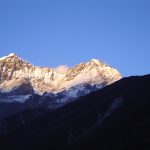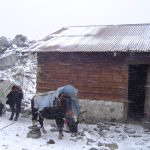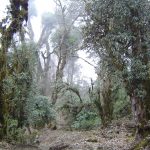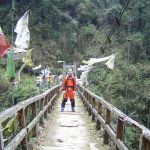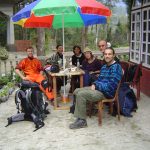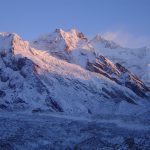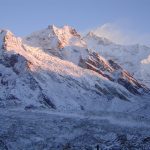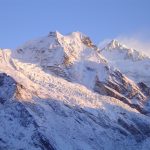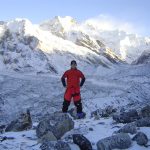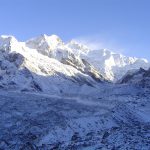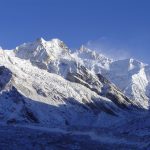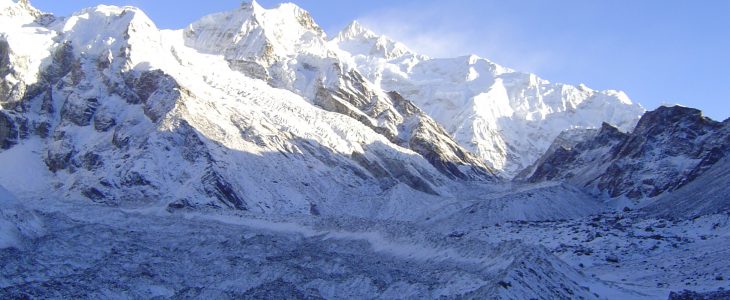
The last nine days I have been far from internet and far from civilization at all. As I wrote in my previous post I joined a very international group for a trek to Goecha La. The group consisted of three women from the US, Great Britain and Switzerland and two other man from Canada and France. Together we went up to the Goecha La viewpoints at around 5.200 m. On the summit day we were extremely lucky to have perfect weather. We saw the third highest mountain of the world, the majestic Kangchenjunga, in all its beauty with no cloud in the sky.
Day I: Yuksom to Bhakim
We went by Jeep from Gangtok to Yuksom the afternoon before and stayed in a small and cozy hostel. This was the last time each of us had their own room for the next nine days. I slept very well and was prepared for the ascent. Unfortunately, I had missed somehow that we could have arranged all our stuff in a large, heavy bag and a small, light bag. The large, heavy bag was supposed to be carried by the two Yaks that accompanied us. We were only supposed to carry the small, light bag. I was not aware of that and, hence, carried my entire luggage of around 18 – 20 kg myself. It turned out not t be too bad, because I was the youngest of the group and my physical condition was better. The heavy backpack balanced that.
The first day was a tough walk. We went up and down for almost 15km. Soon after Yuksom we entered the Khangchendzonga National Park. At this altitude the national park appears a pure jungle area. It was very foggy, but we could still see various rhododendrons and magnolias blooming on our way up. We passed a few bridges which were beautifully decorated with Tibetan prayer flags. I love these prayer flags. Not just because they are beautiful, but also because they make me feel comfortable. I cannot really explain why. Probably, because the closest I feel to any religion is Buddhism.
Day II: Bhakim to Tshoka
I slept surprisingly well. We only had water to wash our face and brush our teeth, but that was enough. I came to know last evening, that we will have only vegetarian food on the entire trek. Thus, it is good, that I have lived in India for a while. I still remember my early days in Chandigarh, when I was desperate for some meat. Within the group we got to know each other a bit better. All five are very nice and we get along well. The walk itself was not very long, which was good after the exhausting walk on the first day. However, I can feel it is going up, because the vegetation changed. There are no huge trees anymore, but only bushes.
Day III: Tshoka to Dzongri
The next day was a bit more challenging. We walked up to Dzongri at around 3.500 m. At this altitude there was not much left of the very diverse vegetation we have seen the first day. Dzongri is a quiet place. There were not many other groups on the trek at the same time. Only two Norwegians with some guides. They were much faster than we were. They overtook us on the way up, but stayed the night in Dzongri, too. Speaking of guides, we have a crew of seven people and two yaks around us. Our guide, two cooks and four Sherpas.
Day IV: Acclimatization
Our guide decided it is better to have an acclimatization day. The altitude gets into the heads quickly. To avoid that, the crew gave us a lot of garlic. Garlic makes the blood thinner and therefore helps its circulation. I did not know that before, but after some reading I know, that the effect is comparable to Aspirin. Thus, garlic is also a natural pain killer. It amazes me, how much I learned about food and its effects on our body here in India. Coming back to Dzongri, the Norwegians have left. They did not feel the need for acclimatization. I took some time to explore the area. The views are already gorgeous at this altitude and I cannot wait to see the Kangchenjunga itself.
Day V: Dzongri to Thansing
Opposed to other groups we did not try the ascent to Dzongri Top. We decided the night before, that we sleep longer and go directly to Thansing. A wise decision, because the weather was not good in the morning. Throughout the day this changed entirely and we had beautiful weather. It really changes very quickly up here. We reached Thansing in the early afternoon. We put up our tents and had some free time. I saw a small creek with crystal clear water. I could not resist the temptation. I took my shirts and sweaters off and washed my upper body with water coming directly from the glacier. Initially, the others thought I was crazy, because the water had at most 2 – 3 °C. However, after five days without a shower it felt very good to clean up at least a little.
Day VI: Thansing to Lamuney
I slept well in the tent. I slept in a good sleeping bag with an extra fleece inlay. During the night the temperature dropped to -25 °C. It must have been very cold in our tent, too. The water in the bottle just next to my sleeping bag was frozen when I woke up. However, I felt very good and relaxed. The walk from Thansing to Lamuney is not very long, but our guide recommended to go early, because the weather changes in the afternoon. Indeed, it did change! Fortunately, there was a small hut and we did not sleep in tents again. Outside there was an enormous snowstorm going on. It actually scared me, because this was the power of nature with all its force. I felt very sorry for the yaks that were outside the whole time.
The Norwegians, that did not spend a day for acclimatization back in Dzongri, had their summit day today. We met them in Lamuney where they just packed up their stuff to return to Yuksom. They were completely devastated, because in their minds all the effort was wasted. They did not see anything of the Kangchenjunga. It must have been disappointing and I really hoped, it would be different for us the next day. Our guide advised us to go and sleep early, because we would get up at 3am the next morning.
Day VII: Summit Day (and back to Thansing)
I have hardly slept last night. It was a mixture of tension, anxiety and the snowstorm blowing in through holes in the wall. I was the one laying next to the wall. It was freezing cold and I wanted to have my cozy tent back. When our guide woke us up I was already awake and did not feel well at all. I left the hut, went behind it and had to throw up. Definitely not the best circumstances for the final ascent on summit day. Fortunately, nobody saw me and I did not tell anybody. I did not want to be expulsed because of my condition. Probably not very sensible, but who thinks rationally when the Kangchenjunga is within reach?
Surprisingly I recovered well and quickly. Soon we were on our way. Harry, the British woman fell down and her gloves got wet. I did not realize this until we were at the top. Her hands must have hurt. When we started in the morning everything was still pitch-black and extremely cold. I reckon the temperature was still below -20°C. We went up with two guides. This time without any backpack. Without those additional 18 – 20kg I was clearly faster than the others. Thus, Josh, our main guide went a little quicker with me. I told him, that I need to get higher than 5.000 m, because that is the highest mountain in Europe. He told me to take me to a place at 5.200 m. The two of us reached the view point 1 after less than an hour. Josh had challenged me with an enormous speed.
However, it was worth it and allowed us to go a little higher. When we stopped it was still dark, but I could see the mountains already. There he was – the Kangchenjunga! With 8.586 m the third highest mountain in the world. Only the Everest and K2 are higher. I took some time to realize how special this is. It became even better, when the sunrise started. I struggle to describe the pure beauty of this natural phenomenon. The sky was absolutely clear. The sun rose behind other mountains and slowly lightened up Kangchenjunga’s peaks. Believe me, it is definitely not the cold, that takes one’s breath away. Stunning, spectacular, marvelous, amazing – none of these words does justice to this majestic beauty I have seen in this exact place in this very moment. I cannot imagine to ever forget this moment and these views.
We spent a long time up there and nobody wanted to leave this place. It was freezing cold, but we did not care. We were so amazed, that the cold became irrelevant. At some point Josh reminded us, that we still have to pack up and walk back to Thansing. We have to pack up every day. It is the National Park’s policy, that nothing can be left behind. I like that environmental conscious thinking. It should be like this on the other treks, too. On the walk back to Thansing I thought of the two Norwegians and the bad luck they had weather-wise the day before. They should have spent the acclimatization day with us – we joked in the group.
Day VIII: Thansing to Tshoka
We slept in a different place than on the way up. The place did not really have a name, but was not far from Thansing. In the middle of the night, all of a sudden John, the Canadian, screamed out loud:
“My face is frozen! My face is frozen!”
We were all awake instantly. It turned out his face was not frozen, but his beard had grown more than he ever let it grow normally. That is what eight days without shaving can do to a grown man. The walk back from Thansing to Tshoka leads through spectacular mountain scenery. The walk was not difficult. Thus, we enjoyed the views even more.
Day IX: Tshoka to Yuksom
The last day we went back from Tshoka to Yuksom. We took a more direct route than on the ascent. We also walked through the impressive jungle area with all its rhododendrons and magnolias again. It was foggy like a couple of days before. It was still a long walk. When we finally reached Yuksom again, we were all really exhausted. Exhausted, but very happy – happy with our group, our crew, the trek, the weather – basically everything. We sat together for a while and talked about some moments we had spent together. After that all of us enjoyed the first shower in almost ten days and slept very well in a proper bed. It felt like luxury.

